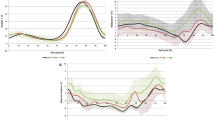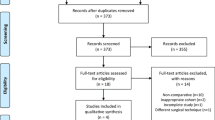Abstract
Purpose
Kinematic alignment in TKA is supposed to restore function by aligning the components to the premorbid flexion–extension axis instead of altering the joint line and natural kinematic axes of the knee. The purpose of this study was to compare mechanically aligned TKA to kinematic alignment.
Methods
In this study, 200 patients underwent TKA and were randomly assigned to 2 groups: 100 TKAs were performed using kinematic alignment with custom-made cutting guides in order to complete cruciate-retaining TKA; the other 100 patients underwent TKA that was manually performed using mechanical alignment. The WOMAC and combined Knee Society Score (KSS), as well as radiological alignment, were determined as outcome parameters at the 12-month endpoint.
Results
WOMAC and KSS significantly improved in both groups. There was a significant difference in both scores between groups in favour of kinematic alignment. Although the kinematic alignment group demonstrated significantly better overall results, more outliers with poor outcomes were also seen in this group. A correlation between post-operative alignment deviation from the initial plan and poor outcomes was also noted. The most important finding of this study is that applying kinematic alignment in TKA achieves comparable results to mechanical alignment in TKA. This study also shows that restoring the premorbid flexion–extension axis of the knee joint leads to better overall functional results.
Conclusion
Kinematic alignment is a favourable technique for TKA.
Clinical relevance
The kinematic alignment idea might be a considerable alternative to mechanical alignment in the future.
Level of evidence
II.




Similar content being viewed by others
References
Bellamy N, Buchanan WW (1986) A preliminary evaluation of the dimensionality and clinical importance of pain and disability in osteoarthritis of the hip and knee. Clin Rheumatol 5(2):231–241
Bellemans J, Colyn W, Vandenneucker H, Victor J (2012) The Chitranjan Ranawat award: is neutral mechanical alignment normal for all patients? The concept of constitutional varus. Clin Orthop Relat Res 470(1):45–53
Bonner TJ, Eardley WG, Patterson P, Gregg PJ (2011) The effect of post-operative mechanical axis alignment on the survival of primary total knee replacements after a follow-up of 15 years. J Bone Joint Surg Br 93(9):1217–1222
Calliess T, Ettinger M, Stukenborg-Colsmann C, Windhagen H (2015) Kinematic alignment in total knee arthroplasty: concept, evidence base and limitations. Orthopade 44(4):282–286
Calliess T, Ettinger M, Windhagen H (2014) Computer-assisted systems in total knee arthroplasty. Useful aid or only additional costs. Orthopade 43(6):529–533
Camarda L, D’Arienzo A, Morello S, Peri G, Valentino B, D’Arienzo M (2015) Patient-specific instrumentation for total knee arthroplasty: a literature review. Musculoskelet Surg 99(1):11–18
Carr AJ, Robertsson O, Graves S, Price AJ, Arden NK, Judge A, Beard DJ (2012) Knee replacement. Lancet 379(9823):1331–1340
Dossett HG, Estrada NA, Swartz GJ, LeFevre GW, Kwasman BG (2014) A randomised controlled trial of kinematically and mechanically aligned total knee replacements: two-year clinical results. Bone Joint J 96-B(7):907–913
Eckhoff DG, Bach JM, Spitzer VM, Reinig KD, Bagur MM, Baldini TH, Flannery NM (2005) Three-dimensional mechanics, kinematics, and morphology of the knee viewed in virtual reality. J Bone Joint Surg Am 87(Suppl 2):71–80
Eckhoff DG, Bach JM, Spitzer VM, Reinig KD, Bagur MM, Baldini TH, Rubinstein D, Humphries S (2003) Three-dimensional morphology and kinematics of the distal part of the femur viewed in virtual reality. Part II. J Bone Joint Surg Am 85-A(Suppl 4):97–104
Hamilton WG, Parks NL, Saxena A (2013) Patient-specific instrumentation does not shorten surgical time: a prospective, randomized trial. J Arthroplast 28(8 Suppl):96–100
Howell SM, Howell SJ, Kuznik KT, Cohen J, Hull ML (2013) Does a kinematically aligned total knee arthroplasty restore function without failure regardless of alignment category? Clin Orthop Relat Res 471(3):1000–1007
Howell SM, Papadopoulos S, Kuznik K, Ghaly LR, Hull ML (2015) Does varus alignment adversely affect implant survival and function six years after kinematically aligned total knee arthroplasty? Int Orthop. doi:10.1007/s00264-015-2743-5
Howell SM, Papadopoulos S, Kuznik KT, Hull ML (2013) Accurate alignment and high function after kinematically aligned TKA performed with generic instruments. Knee Surg Sports Traumatol Arthrosc 21(10):2271–2280
Insall JN, Dorr LD, Scott RD, Scott WN (1989) Rationale of the Knee Society clinical rating system. Clin Orthop Relat Res 248:13–14
Jiang J, Kang X, Lin Q, Teng Y, An L, Ma J, Wang J, Xia Y (2015) Accuracy of patient-specific instrumentation compared with conventional instrumentation in total knee arthroplasty. Orthopedics 38(4):e305–e313
Keshmiri A, Maderbacher G, Baier C, Sendtner E, Schaumburger J, Zeman F, Grifka J, Springorum HR (2015) The influence of component alignment on patellar kinematics in total knee arthroplasty. Acta Orthop 86(4):444–500
Luyckx T, Vanhoorebeeck F, Bellemans J (2015) Should we aim at undercorrection when doing a total knee arthroplasty? Knee Surg Sports Traumatol Arthrosc 23(6):1706–1712
Magnussen RA, Weppe F, Demey G, Servien E, Lustig S (2011) Residual varus alignment does not compromise results of TKAs in patients with preoperative varus. Clin Orthop Relat Res 469(12):3443–3450
Matziolis G, Adam J, Perka C (2010) Varus malalignment has no influence on clinical outcome in midterm follow-up after total knee replacement. Arch Orthop Trauma Surg 130(12):1487–1491
Parratte S, Pagnano MW, Trousdale RT, Berry DJ (2010) Effect of postoperative mechanical axis alignment on the fifteen-year survival of modern, cemented total knee replacements. J Bone Joint Surg Am 92(12):2143–2149
Radtke K, Becher C, Noll Y, Ostermeier S (2010) Effect of limb rotation on radiographic alignment in total knee arthroplasties. Arch Orthop Trauma Surg 130(4):451–457
Vanlommel L, Vanlommel J, Claes S, Bellemans J (2013) Slight undercorrection following total knee arthroplasty results in superior clinical outcomes in varus knees. Knee Surg Sports Traumatol Arthrosc 21(10):2325–2330
Yan CH, Chiu KY, Ng FY, Chan PK, Fang CX (2015) Comparison between patient-specific instruments and conventional instruments and computer navigation in total knee arthroplasty: a randomized controlled trial. Knee Surg Sports Traumatol Arthrosc 23(12):3637–3645
Zhu M, Chen JY, Chong HC, Yew AK, Foo LS, Chia SL, Lo NN, Yeo SJ (2015) Outcomes following total knee arthroplasty with CT-based patient-specific instrumentation. Knee Surg Sports Traumatol Arthrosc. doi:10.1007/s00167-015-3803-5
Acknowledgments
TC, CSC, HW, and ME are consultants for Stryker. This project was supported by the AXIS Foundation for Orthopedic research, Hamburg, Germany.
Author information
Authors and Affiliations
Corresponding author
Rights and permissions
About this article
Cite this article
Calliess, T., Bauer, K., Stukenborg-Colsman, C. et al. PSI kinematic versus non-PSI mechanical alignment in total knee arthroplasty: a prospective, randomized study. Knee Surg Sports Traumatol Arthrosc 25, 1743–1748 (2017). https://doi.org/10.1007/s00167-016-4136-8
Received:
Accepted:
Published:
Issue Date:
DOI: https://doi.org/10.1007/s00167-016-4136-8




